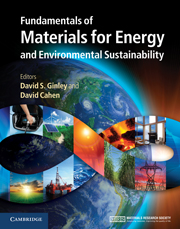Book contents
- Frontmatter
- Contents
- Contributors
- Preface
- Acknowledgments
- Part 1 Energy and the environment: the global landscape
- 1 A primer on climate change
- 2 The global energy landscape and energy security
- 3 Sustainability and energy conversions
- 4 Energy cost of materials: materials for thin-film photovoltaics as an example
- 5 Economics of materials
- 6 Global energy flows
- 7 Global materials flows
- 8 Carbon dioxide capture and sequestration
- Part 2 Nonrenewable energy sources
- Part 3 Renewable energy sources
- Part 4 Transportation
- Part 5 Energy efficiency
- Part 6 Energy storage, high-penetration renewables, and grid stabilization
- Summary
- Appendix A Thermodynamics
- Appendix B Electrochemistry
- Appendix C Units
- Index
- References
8 - Carbon dioxide capture and sequestration
from Part 1 - Energy and the environment: the global landscape
Published online by Cambridge University Press: 05 June 2012
- Frontmatter
- Contents
- Contributors
- Preface
- Acknowledgments
- Part 1 Energy and the environment: the global landscape
- 1 A primer on climate change
- 2 The global energy landscape and energy security
- 3 Sustainability and energy conversions
- 4 Energy cost of materials: materials for thin-film photovoltaics as an example
- 5 Economics of materials
- 6 Global energy flows
- 7 Global materials flows
- 8 Carbon dioxide capture and sequestration
- Part 2 Nonrenewable energy sources
- Part 3 Renewable energy sources
- Part 4 Transportation
- Part 5 Energy efficiency
- Part 6 Energy storage, high-penetration renewables, and grid stabilization
- Summary
- Appendix A Thermodynamics
- Appendix B Electrochemistry
- Appendix C Units
- Index
- References
Summary
Focus
A transition to a low-carbon economy can be facilitated by CO2 capture and sequestration. This chapter focuses on capture of carbon dioxide from industrial emission sources such as electricity generation and sequestration in deep geological formations. A detailed description of the technology is provided, including the potential scale of application, estimated costs, assessment of risks, and emerging research issues.
Synopsis
Today, 60% of global CO2 emissions come from large point sources such as power plants, refineries, cement plants, and steel mills. Reducing emissions from these sources will require reducing demand for the services or materials they provide, finding alternative ways to provide similar services with lower carbon dioxide emissions, or directly reducing emissions by capturing and sequestering emissions. Technology to capture carbon dioxide is available today, but capturing and sequestering CO2 will increase the cost of electricity production by an estimated 50%–100% compared with today's generating costs. Moreover, an estimated increase of 15%–30% of the primary energy supply needed to deliver these services or goods would be required. Captured carbon dioxide can be sequestered in deep geological formations, either onshore or offshore. Sedimentary basins are the preferred location for carbon dioxide sequestration, since they are known to contain both the porous and permeable sandstone formations needed to sequester CO2 and low-permeability rocks such as shale that can trap CO2 for geological time periods of millions of years. The estimated capacity for sequestering CO2 is large and expected to be sufficient for at least 100 years of needed demand. However, the actual capacity for safe and environmentally benign sequestration remains uncertain, since CO2 sequestration has been employed for little more than a decade and only on a small scale. Nevertheless, the basic technologies for sequestration and performance prediction are mature, building on nearly a century of oil and gas production, natural-gas storage, CO2-enhanced oil recovery (CO2-EOR), and acid gas disposal. Enhancements of these technologies will arise as geological sequestration itself matures – but they are sufficiently developed to initiate sequestration today. Regulatory and legal issues remain to be resolved, including issues such as permits for sequestration-project siting, well drilling, and completion, operational parameters such as maximum injection pressures, ownership of underground power space, supremacy of mineral or groundwater rights, and liability for long-term stewardship. Resolving these issues and gaining support for this approach from the public are likely to be the greatest challenges for implementing CO2 capture and sequestration on a meaningful scale.
- Type
- Chapter
- Information
- Publisher: Cambridge University PressPrint publication year: 2011
References
- 2
- Cited by

